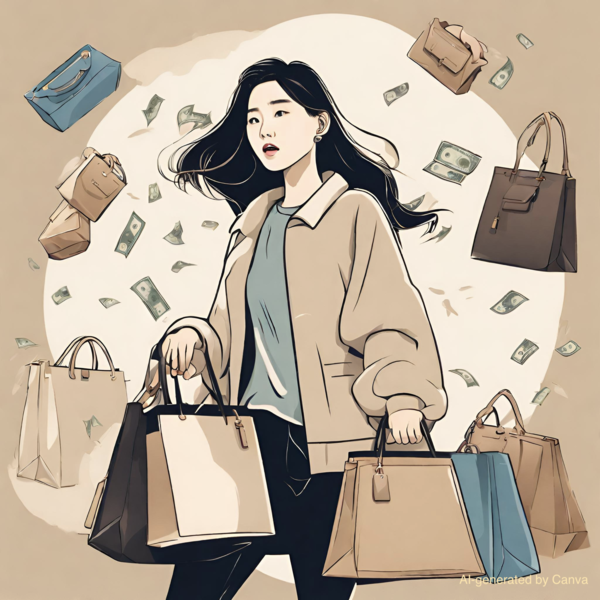Whenever I visit The Hyundai Seoul, the most popular mall in Seoul, I am always amazed by the long queues outside luxury brand stores like Dior and Gucci. What’s truly astonishing is that most of the people in line are women in their 20s to early 30s who are already carrying a handbag of another luxury brand. As someone in the same age group who receives just enough allowance from her parents to survive each month, I couldn’t help but wonder how all these people could live such a completely different life with so much money to spend.

Take one quick look at social media, and you’ll see that it doesn’t just stop at designer handbags. Enjoying fine dining, usually amounting to several hundred thousand KRW per person, going to a five-star hotel just for the sake of relaxing for a day there, purchasing designer brand clothes — everything that we associate with being rich — are prevalent among young Koreans.
A study conducted by investment banking company Morgan Stanley in February reported that South Koreans are the world’s biggest spenders on luxury goods with a “total spending amounting to 325 USD per capita a year”, surpassing 55 and 280 USD per capita spent in China and the US respectively, the two richest countries in the world. In addition, according to Shinhan Card’s big data analysis, the increase in luxury brand consumption among Koreans began with a shift in consumer demographics. Originally, the demand for luxury goods was driven by those in their 40s to 50s, but since the first half of 2021, those in their 20s to 30s have taken the lead. Furthermore, Hyundai Department Store has reported that in 2021, the purchase of luxury items by those in their 20s to 30s has accounted for 48.7% of Hyundai Department Store’s total sales. While some may come from affluent families or have achieved success at a young age, this isn’t the case for most. Then, why are young Koreans spending excessively?
Firstly, Koreans may not perceive excessive spending as negatively as they maybe should. A report from management consulting company McKinsey & Company showed that while 45% of Japanese respondents and 38% of Chinese respondents viewed purchasing luxury goods in a bad light as a way of showing off wealth, only 22% of Korean respondents thought so. There seems to be a common view among young Koreans that regards purchasing goods and services as equivalent to purchasing a valuable experience that will somehow add to their life by helping them learn, change, and grow as a person.
Another reason behind excessive spending is the spread of social media. A 2021 paper by the Korea Service Management Society asserts that there has been an increased desire to convey one’s identity to others through conspicuous consumption in social media. Coined by sociologist Thorstein Veblen in 1899, conspicuous consumption refers to acquiring luxury commodities to display economic power, either to attain or maintain a certain social status. Purchasing high-end furniture, luxury watches, or even collecting vinyl records of classics with no intention of listening to them but just to look “cultured” are all examples of conspicuous consumption. While the desire to flaunt may be inherent in human nature, social media has undoubtedly amplified this inclination. Furthermore, by showing how others are enjoying their lives, social media creates a bandwagon effect, stimulating the herd mentality which leads people to make similar purchases.
The low marriage rate in Korea also encourages excessive purchasing. According to a 2022 study by Statistics Korea, the primary reason for forgoing marriage was a lack of funds for marriage-related expenses, such as renting a wedding venue, dress, and suit. However, the most significant financial challenge comes even before the wedding. Couples are well aware that they won’t be able to afford a house due to the sky-high housing prices, preventing them from living together. These high housing costs extend the financial burden long before and after the wedding day. As a result, many young Koreans perceive these financial burdens as being beyond their ability to manage, and make the decision to forgo marriage altogether. With fewer financial burdens associated with family and marital responsibilities, the young generation now enjoys more financial freedom, as reflected in their increased individual consumption.
In examining the phenomenon of excessive spending among young Koreans, we find a complex web of motivations and consequences that ripple through both individuals and society. On one hand, the allure of luxury goods and the pursuit of extravagant experiences can offer a sense of fulfillment and identity, contributing to personal happiness and a thriving economy. However, beneath the surface of this excessive consumption lies not only financial stress and fleeting happiness but also the potential for inflation and currency depreciation. As young Koreans grapple with their financial choices, it is essential to strike a balance between satisfaction and sustainability.

